13 Best Toppings For Açaí Bowls, According To An Expert
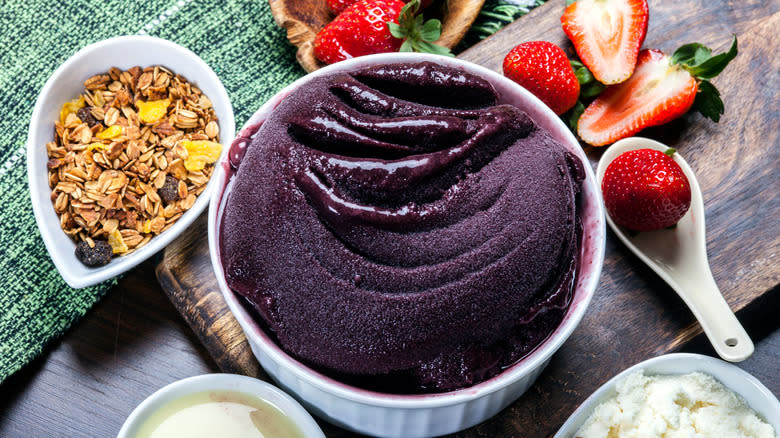
Açaí comes in many forms, from juices and powders to smoothies and sorbets. In Brazil, where this supposed superfood hails from, it's often served in a bowl (açaí na tigela) and paired with all kinds of tempting toppings. The combination of the smooth frozen base with crunchy nuts, fresh fruit, or sugary sweets has made açaí bowls a favorite treat across the country — and, increasingly, all over the world.
Açaí berries are small, round, dark purple, and bitter. Nearly all of the açaí produced in Brazil comes from the state of Pará in the Amazon basin. The berries are harvested from palm trees and processed to extract the pulp, which is frozen and exported. It's usually sweetened with sugar or guaraná syrup, which can obscure the actual flavor of açaí and create the impression that it's naturally sweet.
Some places serve açaí bowls with a specific set of toppings, but many allow you to choose them yourself. In Brazil, certain places have even embraced a self-serve concept that lets customers add unlimited toppings and pay by weight. One such chain is Puro Açaí, which started in 2012 and now has over 50 locations across Brazil. Rodrigo Vellardi opened the very first franchise of Puro Açaí in the city of Fortaleza — so he knows a thing or two about açaí. We spoke with him to gain some insight into the most popular and all-around best açaí toppings.
Read more: The 15 Healthiest Chip Brands, Ranked From Worst To Best
Granola
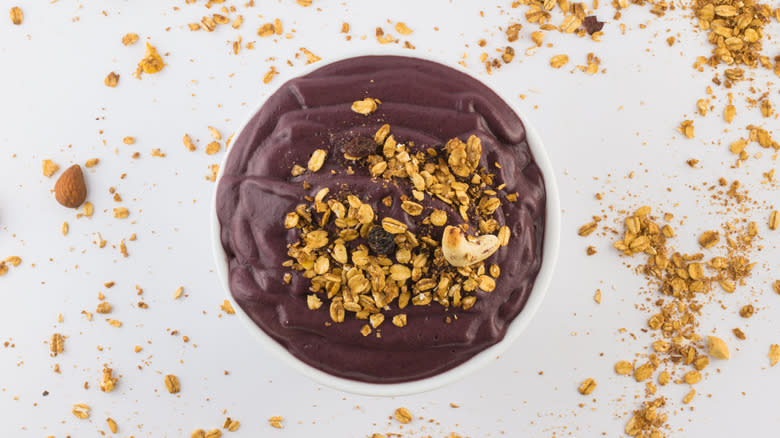
If you're eating açaí in Brazil, granola is a given. It's undoubtedly one of the most ubiquitous and crowd-pleasing toppings for açaí bowls. The crunchiness provides the perfect contrast with the frozen base and adds a bit of extra sweetness as well. The classic Brazilian granola usually contains some combination of toasted oats, corn flakes or other crunchy grains, and sometimes nuts.
Many açaí places even offer multiple types of granola to choose from. At the highly successful Oakberry chain, which has locations in nearly 40 countries, you're likely to find vegan, gluten-free, and low-sugar versions. Rodrigo Vellardi points out that as customers are starting to demand healthier options, it's becoming more common to offer sugar-free, lactose-free, and gluten-free toppings — and that goes for granola, too.
Some spots also offer more creative takes on granola, including things like chocolate chunks or dried fruit. And if you're building an açaí bowl at home, you can easily substitute plain oats, muesli, or cereal for granola. Apart from being delicious, this adds a different texture and an extra nutritional boost to açaí, making it a more filling and well-rounded meal, snack, or dessert.
Fruit
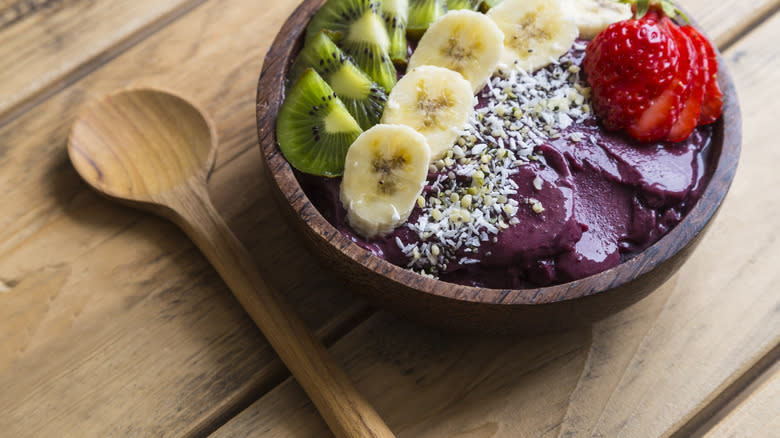
Açaí is often considered a health food, thanks in large part to its high antioxidant content. If you're hoping to enjoy it as a healthy snack, then fresh fruit is an ideal topping. It's also one of the most common toppings you'll find in Brazil, where the default combination is sliced bananas and strawberries.
Other kinds of berries, mango, and kiwi are also popular, but pretty much any kind of fruit would go well with açaí. According to Rodrigo Vellardi, sliced banana remains one of the most popular choices among his customers. It's also one of his personal favorite toppings; he usually combines banana and strawberry with powdered milk and some kind of chocolate.
Another option is to add dried fruit like raisins, cranberries, or goji berries. At Puro Açaí, one of the more unusual requests that Vellardi reports receiving from customers is pure lemon juice — an uncommon topping, but one they'll happily provide.
Paçoca
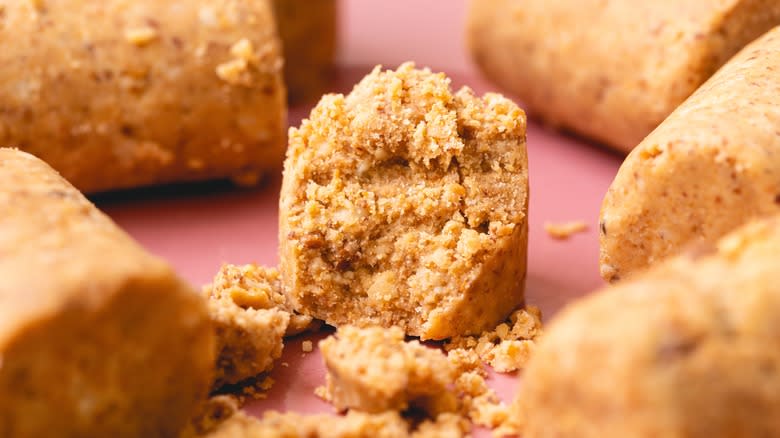
Paçoca can best be described as peanut candy in English, but that doesn't quite capture the magic of this quintessential Brazilian sweet. Made from a simple combination of crushed peanuts, sugar, and just a bit of salt, it might not sound (or look) all that special. But there's something about its perfect ratio of salty and sweet — not to mention its melt-in-your-mouth texture — that makes it incredibly hard to stop eating. It also happens to be a fantastic topping for açaí bowls.
Paçoca usually comes in the form of a small, thick cylinder that starts to crumble as soon as you bite into it. Fortunately, this makes it easy to sprinkle all over your açaí. If you order it at an açaí place, it might already be ground up; at Puro Açaí, customers can literally add paçoca by the spoonful. Note that paçoca is also sometimes called "paçoquita," which is technically a brand name.
Coconut
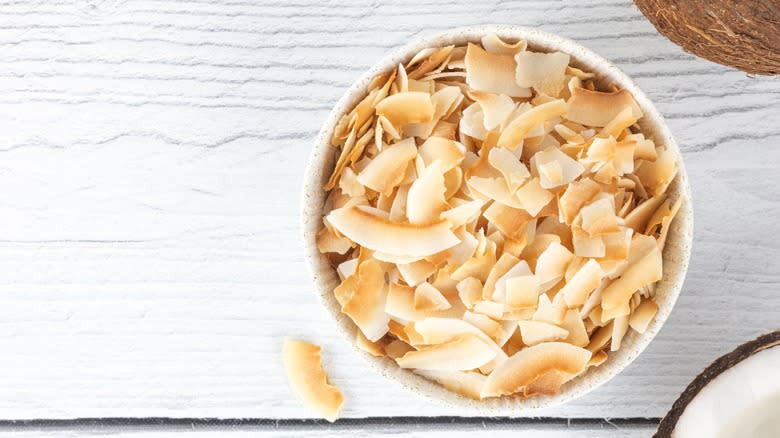
Despite its misleading name, coconut is actually a fruit — but it's popular enough to deserve its own section on this list. Dried coconut is such a common açaí topping that it might seem downright suspicious if it weren't offered as an option at an açaí place. It often comes in shredded form, usually unsweetened, and is sometimes part of the granola that's served with açaí.
You might also be able to order açaí with larger pieces of flaked coconut, either toasted or untoasted, adding another slightly crunchy element into the mix. In Portuguese, these are called lascas de coco or coco laminado, while shredded coconut is known as coco ralado. But no matter what form it's in, coconut's subtle nuttiness and chewy texture make it a delicious addition to a healthy açaí bowl.
It's hardly surprising that coconut is such a common açaí topping, considering its ubiquity in Brazil's cuisine. You'll also find it in many classic Brazilian dishes like moqueca (a traditional seafood stew made with coconut milk) and cocada (a sugary sweet made with shredded coconut).
Nut Butter
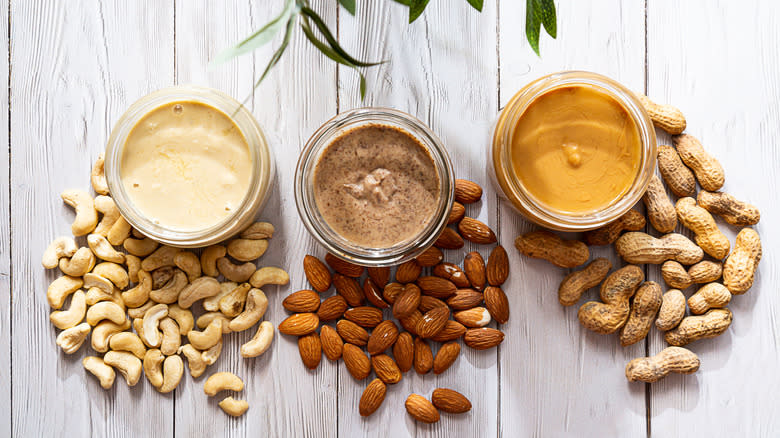
If you're the type of person who puts peanut butter on absolutely everything, there's no reason to stop at açaí. Peanuts in any form (whole, chopped, crushed, candied, etc.) are a perfectly acceptable topping, but peanut butter is an especially delicious addition to an açaí bowl.
Since the açaí itself will likely already be fairly sweet, it's best to go for unsweetened peanut butter if you're preparing it at home. You can even choose a salted variety if you like the sweet and salty combo. As for the eternal debate of crunchy versus smooth, we won't take sides ... but remember that texture is everything in the world of açaí toppings.
Although peanut butter is probably the most common type of nut butter to put on açaí, it's also a great idea to add almond butter, cashew butter, hazelnut butter, or whatever else sounds good to you. Puro Açaí also offers creme de castanha de caju (cashew cream) and creme de castanha do Pará (Brazil nut cream), which aren't actually nut butters but rather semi-frozen, creamy bases that can either be added to or substituted for the açaí itself.
Farinha De Tapioca And Arroz Inflado
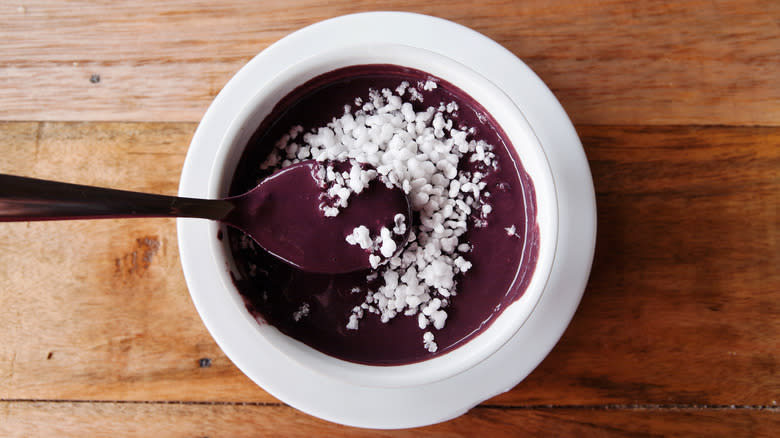
Meaning "tapioca flour," farinha de tapioca is one açaí topping that isn't very well known outside of Brazil. Then again, there are plenty of Brazilian tapioca-related treats that haven't yet gained international fame. An essential Brazilian ingredient, tapioca is technically the starch that comes from cassava. Called mandioca in Portuguese, this white tuber is native to South America (and is also known as yuca).
Farinha de tapioca can refer to a few different forms of this starch, but when it comes to açaí toppings, we're talking about little puffed-up tapioca granules that almost look like tiny pieces of styrofoam. They don't have much flavor, so their main contribution to an açaí bowl is their slightly crunchy and somewhat chewy texture. Note that farinha de tapioca is also the term for the finer, non-puffed tapioca granules that are used to make the crepe-like Brazilian tapioca.
Arroz inflado (literally "inflated rice") is another açaí topping that's usually added for texture rather than flavor. It's exactly what it sounds like puffed-up grains of rice that look kind of similar to farinha de tapioca at first glance, although they're usually a bit more oblong and not quite as bright white.
Nuts And Seeds
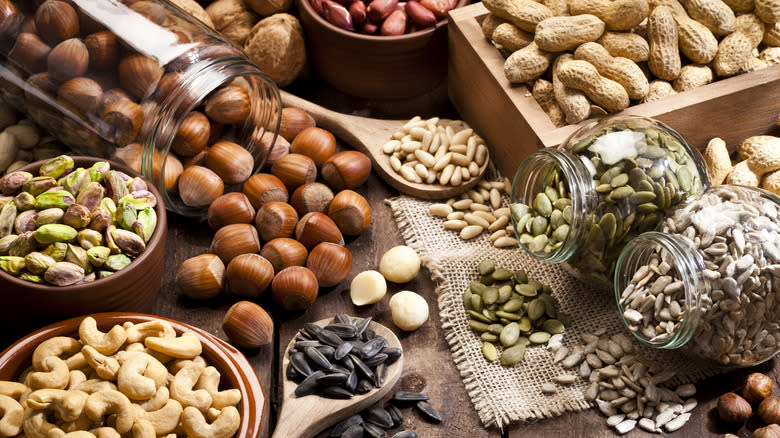
If you're looking to add some crunch, flavor, and nutritional value to your açaí bowl, nuts and seeds are a great choice. That goes for pretty much any type of nut or seed, but some especially common examples are whole peanuts, almonds, cashews, chia seeds, hemp seeds, and flax seeds.
Then, of course, there are Brazil nuts, which unsurprisingly have a different name in Brazil: castanhas do Pará. Yep, that's right: these nuts are named after the same Brazilian state that produces the bulk of the country's açaí. Only about 18% of the Brazil nuts produced in Brazil actually come from Pará; the rest are grown in the country's other Amazonian regions.
While it's common to add whole, sliced, or chopped nuts to açaí, sometimes you'll also see a finely shredded substance called farinha (literally "flour"): for example, farinha de amendoim (made of peanuts) or farinha de castanhas de caju (made of cashews). As for creative takes on seeds, at Oakberry and some other chains, you can also add a scoop of chia pudding to your açaí bowl.
Honey Or Agave Syrup
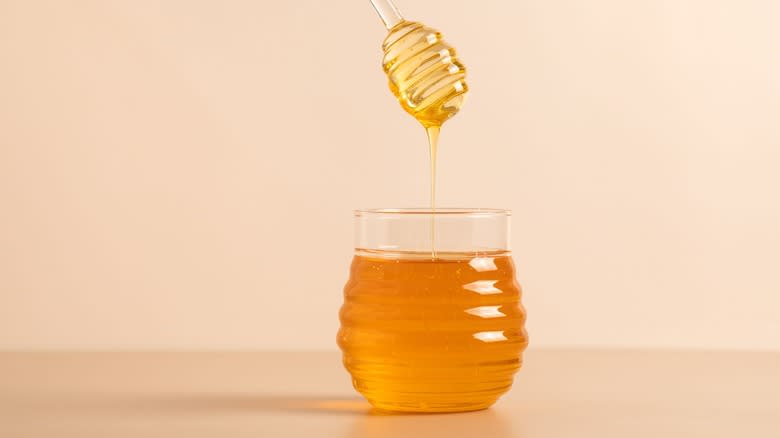
Açaí is incredibly common not only in Brazil, but also in Portugal — which makes sense considering the cultural ties between the countries and the high population of Brazilians living there. And when you order an açaí bowl in Portugal, it often comes with a default set of toppings: granola, sliced banana and/or other fruits, and honey.
Some people might consider the honey unnecessary, as the açaí and granola are already pretty sweet. But for others, it adds an extra punch of sugar and brings out the natural flavors of the fruit. If you want to keep your açaí vegan, you can also sweeten it with agave syrup — or even maple syrup — instead of honey.
While we're on the subject of sweeteners, let's dive a bit further into the way açaí itself is sweetened. Although most pre-packaged açaí puree has added sugar in some form, in Brazil there are some places that serve it pure and unsweetened. At Toca do Açaí in Fortaleza, customers can choose from a long list of fruits to be blended together with the açaí, sweetening it naturally. It's also possible to order plain açaí, which is an essential experience if you've ever wondered what the fruit actually tastes like on its own (it's notoriously hard to describe).
Creme De Cupuaçu
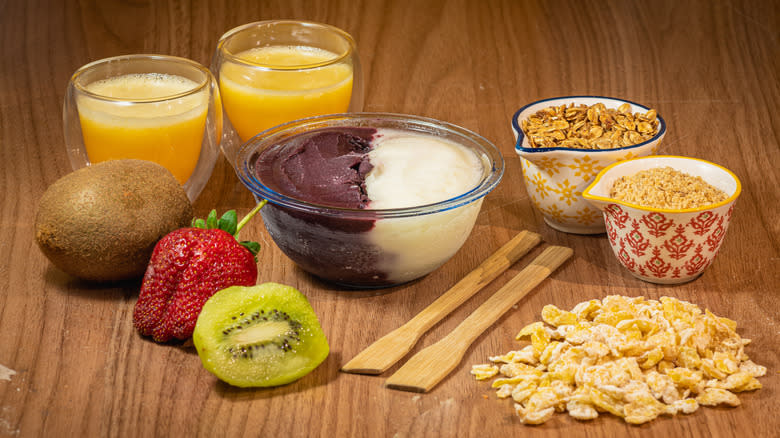
At some açaí places, you'll find a creamy concoction called creme de cupuaçu. Literally meaning "cupuaçu cream," it's a smooth substance that's white or off-white in color. Beyond adding it as a topping, in some cases, you can order a bowl with a base of half açaí, half creme de cupuaçu (sometimes called "casadinho").
Cupuaçu is the name of a tree that grows in the Amazon and produces large brown fruits that contain soft white pulp. This pulp is the base of creme de cupuaçu, usually made with condensed milk and cream as well. If you're planning to use it as a base alongside açaí, it's best to partially freeze it first to make the consistency a bit thicker (and match the temperature and texture of the açaí).
Puro Açaí not only offers creme de cupuaçu but also several other creative bases to complement or replace the classic açaí. There are fruit-based options like creme de maracujá (passion fruit cream) and creme de morango (strawberry cream), plus some recent additions based on native fruits from Pará: creme de bacuri (a brown fruit with white pulp) and creme de buriti (a small red fruit with yellow flesh). Rodrigo Vellardi also suggests mixing açaí with creme de leite (powdered milk cream) or creme de tapioca (tapioca cream).
Condensed Milk
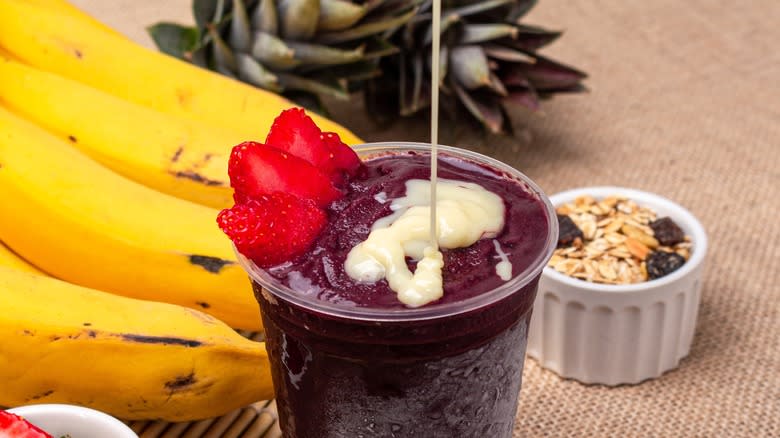
Speaking of sweet substances to drizzle atop açaí, it would be a downright travesty to leave condensed milk (leite condensado in Portuguese) off this list. This incredibly sugary, creamy dairy product is a mainstay of Brazilian desserts, featuring in everything from brigadeiros to beijinhos (coconut truffles).
Just like honey and agave, condensed milk makes an açaí bowl a bit sweeter and more indulgent. It's also an especially good topping to pair with naturally tart fruits like berries or kiwi, as it can balance out the sour flavor.
If you're already topping your açaí bowl with sweets like paçoca or other candy, be careful not to overdo it on the condensed milk — when you combine it with a sweetened açaí base and natural sugars from fruit, it's easy to end up with an achingly sweet result. Unless you have an incredibly strong sweet tooth, it might be better to choose one or two sugary elements to pair with more neutral toppings like nuts, coconut, or puffed rice (but that's just our advice).
Powdered Milk
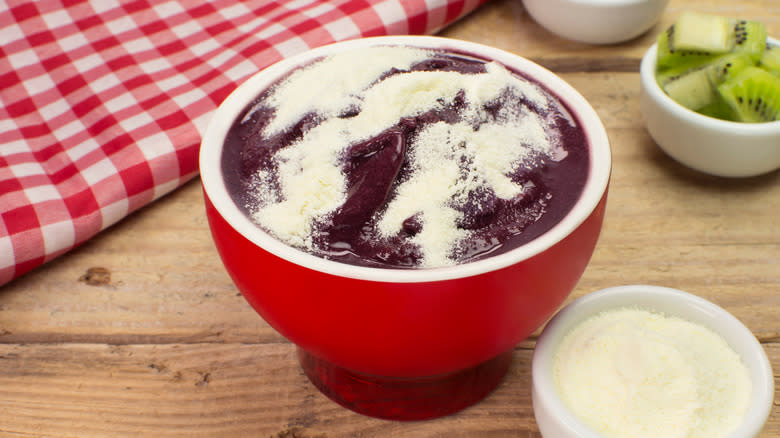
Leite em pó, or powdered milk, might not have caught on yet as an açaí topping around the world. But it's a common sight on many menus in Brazil — and one of the top three most popular toppings among Rodrigo Vellardi's customers at Puro Açaí. It's also one of his personal favorites.
You might also hear leite em pó referred to as leite ninho. This is a reference to the most widely known brand of powdered milk, Nestlé Ninho, which was originally intended for kids. The word ninho might sound very similar to niño, the Spanish word for "child," but in Portuguese, it means "nest." It's essentially powdered whole milk with vitamins added, including calcium, zinc, iron, vitamin A, and vitamin C.
Powdered milk does contain natural sugars from dairy, but it isn't usually sweetened. Because leite ninho is made with whole milk, it tastes a bit fattier than some other brands of powdered milk and adds an element of richness to açaí. When the super-fine white powder is piled atop an açaí bowl, it almost looks like snow. Both the color and flavor provide a striking contrast to the dark purple puree below.
Chocolate And Candy

Part of the allure of açaí is that it can be a whole meal by itself — even if it looks and tastes more like a dessert. But if you want to go all out and abandon any notion that you're enjoying a healthy treat, a whole category of açaí toppings awaits you: chocolate, candy, cookies, and more. In Brazil, it's quite common to find colorful sweets on an açaí menu. According to Rodrigo Vellardi, chocolate (in various forms) is among the most commonly sold toppings at Puro Açaí.
If you're in the mood for chocolate, you can add chocolate chips, chocolate shavings, chocolate syrup, or even Nutella to an açaí bowl. For a healthier take on the same concept, try cacao nibs.
As for the candy, the most common choice is also chocolate-based: colorful candies like M&M's. People also add marshmallows, candy bars, Oreos, and pretty much any other sweet you can imagine. Whether or not these treats complement the fruity flavor of the açaí is up to interpretation, but plenty of people can't get enough of it.
Shrimp
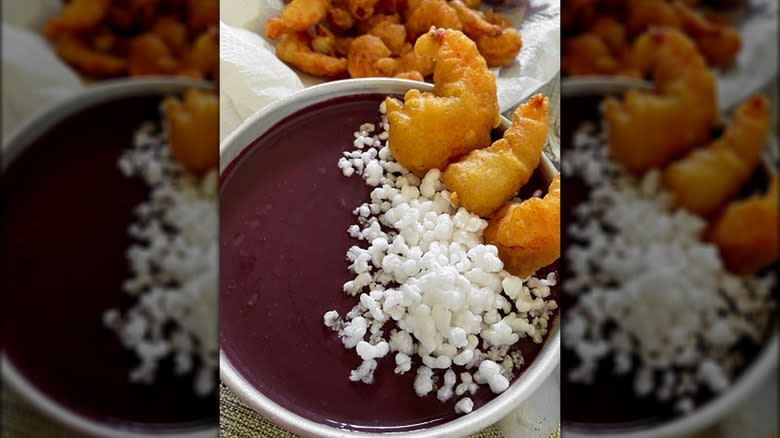
Let's be clear: you're probably not going to find shrimp on the menu of an average açaí place, whether in Brazil or abroad. But we've included this item to highlight an interesting fact about açaí, and to reinforce the point that the berry itself isn't actually sweet.
In Pará, where more than 90% of Brazil's açaí comes from, the fruit is a core ingredient in traditional savory dishes. Pureed, unsweetened açaí is often paired with puffed tapioca granules (farinha de tapioca) and whole shrimp (camarão). It's also eaten with other types of farinha and protein sources like fish or chicken.
One could argue that this is among the most authentic ways to eat açaí, considering that it's associated with the place where açaí actually comes from. But in other parts of Brazil, it's far from well known. In 2021, Pará news outlet DOL reported that a Youtuber from Minas Gerais, a state in southeastern Brazil, had shared a photo of açaí with shrimp, expressing disbelief that it could be eaten this way.
He immediately received thousands of responses explaining that there's nothing atypical about this dish in Pará. One commenter even pointed out that to people from Pará, eating açaí with other toppings (like fruit and sweets) seems just as illogical. In other words, there are really no rules when it comes to açaí toppings; it all depends on cultural context and personal tastes.
Methodology
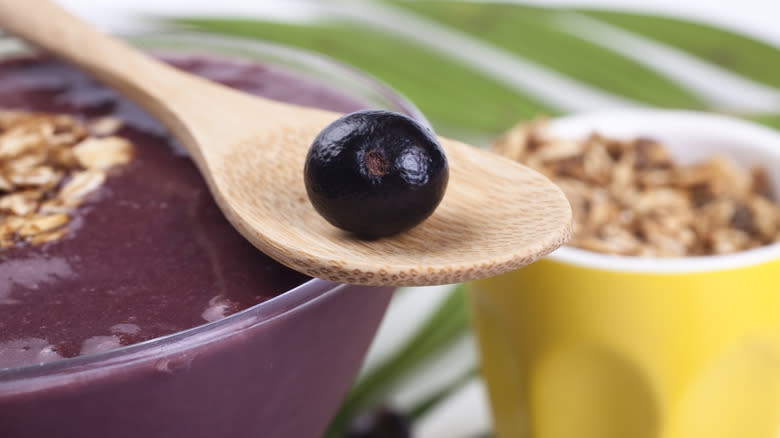
Any list of the best toppings for açaí bowls (or anything else) is ultimately subjective — we all have our favorites, and the ideal accompaniments can also vary depending on what you're in the mood for. That said, there are certain toppings that simply must be mentioned due to their ubiquity, authenticity, or just downright deliciousness.
To select the toppings for this list, I first considered the most common items you'll find at an average açaí place in Brazil. To get an insider perspective, I spoke with someone who has firsthand experience with running a Brazilian açaí franchise. I also based many of the selections on my own personal experiences eating açaí in both Brazil and Portugal.
I've tried most of the toppings on this list, but to learn more about the ones I haven't, I consulted a Brazilian friend who's tasted pretty much every açaí topping under the sun — and then supplemented their opinions with research.
Read the original article on Tasting Table

